 BioCycle December 2010, Vol. 51, No. 12, p. 29
BioCycle December 2010, Vol. 51, No. 12, p. 29
Converting waste to resources benefits college students, campus farms and gardens, facilities management and the greater community. Part III
Dan Sullivan
COLLEGES and universities have taken a variety of approaches to establishing composting programs on campus. In Part I of this series (July 2010), we focused on programs that integrated composting into the curriculum. Part II, in September, profiled projects launched by students. In this final installation of BioCycle’s campus composting series, we look at closing the loop between food waste diversion, campus farms and utilizing food grown back in the dining halls. We also shine the spotlight on compost programs initiated through campus physical plants.
Every campus composting project interviewed in the series – a total of 30 – cited savings in waste management costs and the environmental benefits of landfill diversion as the primary reasons for getting involved in food waste recycling. In almost every instance, a portion or all of the finished compost is utilized in campus gardens and on farms, as well as for landscaping.
FARM TO PLATE AND BACK TO FARM AGAIN
Berea College, Berea, KY
Berea College has been composting for 12 years. “We use windrows turned with a front-end loader,” says Sean Clark, associate professor and chair of the college’s Department of Agriculture and Natural Resources. “The composting area of the farm is located less than a quarter of a mile from the food service loading dock where the buckets of food residuals are picked up daily.” Feedstocks include all food residuals from the dining hall, municipal leaves and wood chips (when available), sawdust from the College’s woodcraft program and, occasionally, spoiled straw or hay.
The college received a $1,000 grant from the Organic Farming Research Foundation to start a pilot project in 1998. “The original pilot was a collaboration between a student and a faculty member in order to generate a fertility source and a potting medium for the organically-managed horticultural operation of the College Farm,” explains Clark. “At the time we began composting we were growing fruit, vegetables, herbs and flowers on about 3 acres of land. Today, we generally produce these crops on 5 to 8 acres annually. The compost is used as the sole ingredient in our potting medium for almost all of the crops we grow as transplants, and it is applied to the fields at about 5 tons/acre every two to three years and to the high tunnels used for winter production every year. About a fifth of the produce grown is sold back to the college’s food service for student consumption, completing the cycle of waste back to food.”
While students are made aware of the composting program, kitchen staff is responsible for separating the food waste. “We attempted to expand the initial pilot project, which collected only preconsumer residuals, to include all postconsumer residuals from the plates of students as they returned their trays after eating,” Clark recalls. “Although we worked hard to educate everyone on what was and wasn’t compostable, this proved too difficult for some. The material we collected was contaminated with plastic packets and bottles, metal utensils and even cups and plates. After one year, we gave up on the postconsumer collection and only resumed it when the kitchen staff took over separation about three years ago.” Today, nearly all campus food residuals are processed and used at the College Farm. Some courses at the college – such as Soil Science, Introduction to Sustainability and Environmental Studies – use the composting operation for laboratory or field experiments.
 Dickinson College, Carlisle, PA
Dickinson College, Carlisle, PA
Two Environmental Studies majors initiated a Student Garden in 1999 as part of their senior research project. As interest in the garden grew, the Environmental Science department sought a way to ensure its longevity and, in 2000, the college dedicated a three year Innovation Grant to the project. By 2002, Jen Halprin had been hired as a part-time garden director, and composting of dining hall food waste began on a small scale with hand-turned piles. Over several years, this built to the present level of composting with approximately 500 lbs/day of food waste taken in for processing in tractor-turned windrows. Additional feedstocks include municipal leaves, wood chips from campus and a local tree service and produce waste from what has expanded into an on-campus vegetable farm managed by Halprin full-time.
“We started the program on our own with no [outside] grant funding,” explains Matt Steiman, assistant farm manager. “In 2008, the college was awarded a Pennsylvania Department of Environmental Protection composting infrastructure grant to increase the amount of food waste collected. This $96,000 grant paid for a Hobart pulper/extractor for the cafeteria, which significantly reduces the water volume needing to be transported while also increasing the surface area of the food waste for faster composting.” It also reduced contamination because sorters remove most of the noncompostable garbage before pulping. The grant enabled purchase of a manure spreader for turning/spreading the compost, a used loading tractor and a used pickup truck for hauling the food waste. “The dining hall was able to eliminate one Dumpster from their waste stream due to the composting program and recycling,” says Steiman. “Previously they pulled two Dumpsters each day; now they are down to one.”
Most of the compost is used on the campus farm, where six acres of vegetables are grown each year. All of the produce is used in the local community. The student cafeteria uses the biggest volume, followed by the “campus supported agriculture” CSA (in order to avoid competition with other local farmers, says Steiman, you must be a member of the Dickinson community to join), the local farmers’ market, the community food bank and five local restaurants.
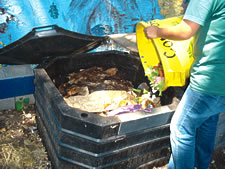
California State University, Chico
Driven by their passion for environmental issues and a desire to reduce the campus waste stream, the Associated Students at California State University (CSU), Chico, launched a compost program in 1995, explains Eli Goodsell, Associated Students Recycling (ASR) Operations Coordinator. The initial program was funded through a grant from the university and revenue from campus dining services. The recycling and composting program is now sustained through student fees. Feedstocks include pre and postconsumer food scraps, yard trimmings and soiled paper. “Last year we collected more than 180,000 pounds of food scraps, which were picked up by students and brought to our University Farm to be composted,” Goodsell says.
Recently CSU Chico partnered with Recology to manage campus food waste, enabling ASR to compost more materials than the student farm could handle. “This new partnership allows us to expand our composting program,” says Goodsell, adding that 1,500 pounds more of food scraps are being recycled monthly. “Our goal is to expand postconsumer food waste from our main dining hall to another market-style dining facility on campus, which could double the amount of material collected daily.”
A portion of the finished material is brought to a Compost Display Area (CDA) on campus, where two Compost Education Coordinators provide workshops for university and K-12 students and the general community (reaching more than 750 people last year). The Associated Students —- a state university system auxiliary that manages all campus food services, the campus gym, and hosts numerous student organizations – has adopted a zero waste by 2015 goal. “We believe that our expanded composting program will be the largest step to accomplishing this goal,” adds Goodsell. “My advice for any school or business is not to wait for a composting facility to open but get started with worm bins in the office or in passive piles on any piece of land. If we had waited for a composting facility to open up, more than a million pounds of our compostable food scraps would be in the landfill instead of nurturing the soil in our community.”
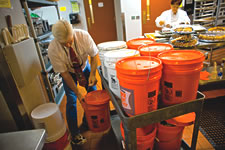
Kean University, Union, NJ
Kean University’s composting program began in February with the unveiling of a custom designed, aerobic in-vessel drum capable of processing 1,000 pounds/day of campus-generated food scraps. Wood chips from a nearby cabinet manufacturing facility, and more recently wood pellets, are also added as part of the composting process. A stockpile of 3,750 pounds of pellets costs just under $300 and lasts about a month, says Nicholas Smith-Sebasto, co-executive director for the School of Environmental and Life Sciences at Kean, who designed the new drum.
The only real challenge setting the project up revolved around getting permits for the building in which the composting system is located. “In the early stage of the project, too many contaminants – latex gloves, silverware, etc. – were in the collection buckets. Some contaminants are still being found, but to a much lesser extent.” Smith-Sebasto expects about 60 tons of food waste will be composted during this academic year. Finished compost is used on various campus landscaping projects, including a garden maintained by students where the vegetables and herbs are used in the dining hall.
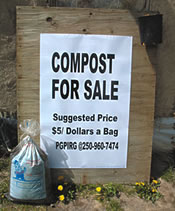
University Of Northern British Columbia, Prince George
The composting program at the University of Northern British Columbia (UNBC) began in 1995 as a joint project of the nonprofit Recycling and Environmental Action Planning Society (REAPS) and Prince George Public Interest Research Group (PGPIRG). The program includes UNBC Food Services, grounds maintenance, residence halls and the greater campus community. “We have compost bins at our site on campus that hold about 2 cubic yards (cy) of composting material,” says D’Arcy Michiel, compost coordinator for the on-campus chapter of PGPIRG. Feedstocks include food scraps, coffee grounds and sawdust. A prolific organic garden at the site demonstrates the value of compost. Any student, faculty or staff member can use the UNBC compost site; receptacles are provided throughout the campus and in the residence halls.
“Our compost collection is performed by volunteers,” says Michiel. “This is the most challenging aspect of our composting program. We have very low temperatures up here in Northern Canada, and that can deter some volunteers from doing their job.” PGPIRG recently purchased a 1-cy Dumpster-style container with a grant awarded through UNBC’s Green Fund that is financed with parking revenues. “The volunteers deposit the daily compost collection into this container, which is then taken out to the composting site once a week by a UNBC groundskeeper,” she adds. “This way the volunteers do not have to trek outside in the winter.” Finished compost – processed with more than 26,000 pounds of collected feedstock annually – is also bagged and sold to the greater community via a self-service honor system.
PHYSICAL PLANTS SEE THE VALUE OF COMPOSTING
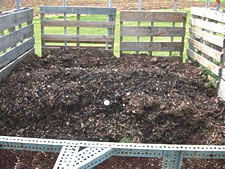
Clemson University, Clemson, SC
“We have been doing static pile composting for quite some time but started an in-vessel program this past summer,” says Dave VanDeventer, campus recycling manager, adding that both methods continue to be utilized. Feedstocks include mainly food scraps for in-vessel composting and yard trimmings for the static pile. The initial and expanded projects were initiated by students, faculty, physical plant staff and the sustainability office, adds VanDeventer. The South Carolina Department of Health and Environmental Control Office of Solid Waste Reduction and Recycling contributed $25,000 toward the purchase of the in-vessel equipment, which, following a competitive bid process, came from BW Organics in Sulphur Springs, Texas. The Model 512 unit has a 6-cy operating capacity with a 2 cy/day continuous flow throughput. It has been operating for about four months, processing about 12,000 pounds of food scraps in that time. “We have had issues with too much moisture content in the food waste and not being able to get our temperatures up to the optimum level,” he says. “We believe the food pulpers used in our dining services areas are allowing too much water through. We are still in the learning process and not able to use the compost yet as we are allowing more cure time … We see a lot of potential once we get our mixtures correct.” The finished compost is used on campus landscaping projects and a student farm.
Coe College, Cedar Rapids, Iowa
Coe College has been composting for three years, hauling preconsumer food waste from the kitchen and postconsumer food waste generated by 900 students and faculty to an off-site facility 240 days a year, explains Tom Wieseler, general manager of Sodexo Campus Services. “During a summer 2005 dish room remodel, I requested a pulper to be put in versus garbage disposals. For two years, the pulped mix went into the regular garbage and to the landfill. Beginning in May 2007, we would save about five trashcans of pulped material over a seven-day period and take it to a city/county compost site. The weight was taken each week, so we know how much has not gone into the landfill.” By the end of the 2009/2010 school year, nearly 48 tons had been diverted.
Selling the idea initially to kitchen staff and the administration was tough, Wieseler adds. “But the administration has been very supportive. The biggest challenge for me is dumping the five cans of pulp each week and taking it to the composting facility! The cost is about $8/load/week.” Knowing that the waste is going back into the ecosystem in a positive way makes it all worth it, he says. “This was the next step in our sustainability efforts. When Coe College evaluated stopping the use of cafeteria trays, I was able to use data on the amount of tray waste to show that we saved 285 pounds of food per week that we weren’t composting by not using trays. We can say we do zero waste meals/picnics/midnight breakfasts because all waste is pulped and composted.” Finished compost is available for purchase. “I buy back some for our campus garden each spring,” Wieseler adds.
Cornell University, Ithaca, NY
At Cornell, compost feedstocks – including food scraps, yard trimmings, soiled paper, all PLA packaging and corn- and potato-based tableware – gets taken to Cornell Farm Services, about 20 miles from the main campus. The 5-year-old project was initiated by students and food service staff concerned about waste, explains Therese O’Connor, a manager for Training & Development and Sustainability Initiatives at Cornell. “Because Cornell has a large College of Agriculture and Life Sciences College, there are many crop-based and animal-based sites around and outside of the county,” she says. “Farm Services produces compost and supplies the various farms.” Payoffs of the program, adds O’Connor, include “seriously reducing the landfill tonnage that we were producing, seeing the ‘full cycle’ of food/plants to waste to farm to food and an appreciation on the part of the community to do the right thing.”
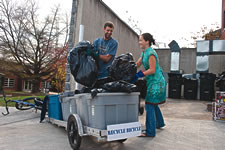
Eastern Mennonite University, Harrisonburg, VA
Eastern Mennonite University (EMU) has been composting yard trimmings since the early 1970s and food scraps and napkins from the cafeteria since 2004. Occasionally, a manure and wood shavings bedding mix is added in to boost nitrogen and serve as a bulking agent. Even though organics have been composted at EMU for many years, it wasn’t until recently that the program got a shot in the arm. “The compost pile was never turned or managed and thus was full of weeds and poorly decomposed material,” explains campus Recycling and Waste Reduction Coordinator Jonathan Lantz-Trissel. “Physical plant staff tried to get money to upgrade the program, but there wasn’t support from the institution at the time. In 2009, a faculty member offered a one-time composting class that brought students, faculty, food services and the physical plant together to start a managed windrow composting program. After the class finished, the student environmental club Earthkeepers and EMU Recycling – based in the Physical Plant – took over operations and monitoring of the compost.” Food scraps from the cafeteria are collected via two 8-foot long bicycle trailers powered by students.
Lantz-Trissel adds the class showed the value a composting program could bring to campus. “It brought all the different groups to a common understanding of what we were working toward and grew students’ ownership of composting as they set up the collection process in the dining hall and brought the food services company onboard. Switching the cafeteria trash from Dumpsters that are a volume charge to self-hauling at a per-pound cost also proved helpful, as it established a monetary incentive for the university to reduce food scraps in the waste stream.”
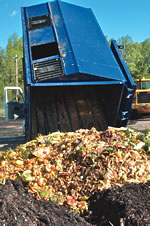
Syracuse University, Syracuse, NY
Syracuse University began a full-fledged composting program in February 2010, after being involved in a pilot project. All preconsumer food waste is hauled offsite to a facility run by Onondaga County Resource Recovery Agency (OCRRA). “Diversion of postconsumer waste is being implemented slowly throughout the dining centers operation,” says Melissa Cadwell, recycling and composting coordinator for Syracuse University’s Department of Energy and Computing Management. A total 18.33 tons of food waste were composted in the first semester of the new program.
Syracuse University joined OCRRA’s food waste composting program as a pilot partner in January 2009. “This program offers numerous advantages,” says Cadwell. “As the county waste management authority, OCRRA is a stable, expert and trustworthy partner with no commercial motivation and a longtime good working relationship with the university.” The authority’s tipping fee amounts to half the university’s historical waste disposal fee, and OCRRA waived all fees for the first six months, she adds. Community members can purchase compost for $5 to $15/cy, depending on the product, quantity and whether there’s a load fee.
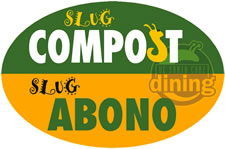
University Of California, Santa Cruz
UC Santa Cruz is now in its third year of ramped-up composting, which now involves all five campus dining hall kitchens. “We haul to an offsite facility, which blends and windrows the material,” explains Recycling Coordinator Dave Wade. “We were initially working with Santa Cruz County but are currently hauling to a facility in Monterey County, run by the Monterey Regional Waste Management District. We are composting pre and postconsumer food scraps and coffee grounds from our dining halls, plus compostable service ware and paper napkins from catered events.” The program is a collaboration between Recycling, Grounds Services and Dining Services.
A pilot was operated for a few years about a decade ago, with student employees building static piles out of kitchen prep scraps, coffee grounds and wood chips. “We made some good compost, but it was too labor intensive and small scale to be practical or make a big reduction in what we sent to the landfill,” says Wade. Several years ago, the university installed solar-powered compactors in all dining halls to reduce the number of pickups as well as worker injuries from handling heavy kitchen wastes. Composting capacity opened up when Santa Cruz County started a pilot program at its landfill, blending food scraps from local schools and restaurants with curbside collected green waste.
“When we realized that most of what was going into the compactors was compostable material, we reached out to the county to be included in their program,” recalls Wade. “After some initial uncertainty, we were invited to participate.” When permitting and other issues recently caused Santa Cruz County to suspend operations of the program until problems can be resolved, “we were fortunate to find the program in nearby Monterey County and work out an agreement with them,” he adds. Reluctance to truck the material the longer distances was offset by a lower tipping fee for compostable material. “In addition, the tonnage counts towards our waste diversion goals,” explains Wade. Another challenge was making sure the stream sent out for composting is clean. Dining Services launched an extensive training program for all staff, complete with special containers, logos, scorecards and inspections. “Since July 1, 2009, we’ve sent over 265 tons of material to compost instead of to a landfill,” he adds.
University Of Pennsylvania, Philadelphia
The University of Pennsylvania’s (Penn) sustainability platforms include: energy and utilities, physical environment, academics and communication, transportation, waste minimization and recycling. “We actually have all of that woven into class work, research and the academic life of our students and faculty, and into our degree programs, courses and cross-disciplinary work,” says Marie Witt, vice president of business services.
All food waste from four dining halls, Penn’s other retail venues and catering services are hauled to Peninsula Compost about 40 miles away in Wilmington, Delaware (see “Urban Facility Delivers Food Waste Composting Capacity,” June 2010). “As soon as we heard it was up and running we were delighted,” says Laurie Kusard, director of dining services. During the school year, a local waste hauler makes two trips weekly to deliver about 4.4 tons of food scraps to Peninsula.
Kusard describes Penn’s successful composting program as a collaboration between food services, the campus concessionaire Bon Appetit and facilities management. “We did the easy part first,” she explains. “In the dining halls and kitchens there is very little waste other than food waste – some cardboard and paper napkins – and most of it is either recycled or composted. The challenge is retail.” Changing behaviors around convenience packaging is tough, even when it is compostable or recyclable, requiring more sorting in the back of the house. “We already separate paper, bottles, plastic and cans from other kinds of trash,” she says. “Now we’re pulling out the compostable components. It is less expensive to send the food waste to Peninsula than it is to landfill it -about a 10 percent decrease in cost. But we would have done it even if it was cost neutral, and we would have discussed it if wasn’t. Doing the right thing is good business for a variety of reasons.”
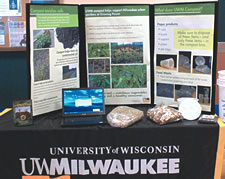
University Of Wisconsin Campuses
The University of Wisconsin (U of W), Milwaukee has been composting since spring 2009, hauling vegetative food scraps and paper food containers to nearby Growing Power, a nationally recognized nonprofit that supports self-sufficient community food systems through active demonstration. “The program was set up by a partnership between the sustainability office and Restaurant Operations on campus,” says Kate Nelson, campus Environmental Sustainability Coordinator. While challenges have included training staff and modifying the behavior of students through education and signage in the dining halls, recycling 2,000 pounds of organics and building community relationships have provided ample rewards.
At U of W Stevens Point (UWSP), raw fruit and vegetables, grass, leaves and sod are composted via both static pile and vermicomposting, says Buildings & Grounds Superintendent Chris Brindley. Finished compost is used as topdressing on campus lawns and in perennial beds. U of W Superior has been composting food scraps for about 18 months, contracting with an offsite vendor and facility, explains campus Director of Facilities Management Tom Fennessey. “The program was generated by several forces – students, the dining service contractor, the sustainability office and local early adopters,” he says. Finished compost is available to area homeowners.
U of W Stout has been composting since January 2010. “Veolia, our local contracted waste hauler, had created a composting area at its landfill,” says Ann Thies, campus dining director. “We have them pick up the food waste and add it to the windrows there.” Materials diverted include food scraps and compostable packaging and paper that’s incidental in food production and service, adds Thies. “Collection is now from back-of-the-house areas and from customer tray returns when employees are involved in scraping them. The program was initiated by dining services who contacted the local waste hauler when we heard about Veolia’s composting program. We then arranged meetings with local food establishments – restaurants and institutions – to promote joint efforts in the community. The university selected to begin the program so this opportunity can be available to others and eventually the cost of pick up will be shared by others.”
December 22, 2010 | General










